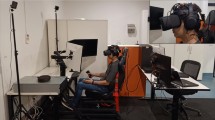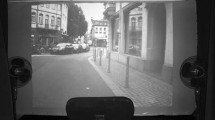Abstract
Immersion in virtual environments can cause simulator sickness (SS). Further, head and neck movement in interactive virtual reality (VR) assessment and training stimulates the vestibular and cervical afferent systems that can cause dizziness in subjects with neck pain and vestibular pathology. This cross-sectional, observational, study investigated SS and factors that may influence this between 20 neck pain, 14 vestibular pathology and 20 asymptomatic control subjects. Pre-VR questionnaires included a visual symptom scale and dizziness intensity. SS measures included the simulator sickness visual analogue scale and the simulator sickness questionnaire. Significantly greater incidence of any SS and higher values were found in the vestibular and neck pain groups compared to the control group in selected SS measures. No significant differences were found when comparing SS measures between the vestibular and neck pain groups. Significant mild-to-moderate correlations for the entire population were found between both SS measures to pre-VR visual symptoms and dizziness intensity. SS levels in neck pain and vestibular populations are comparable and higher than asymptomatic individuals. Dizziness and visual disturbances may be associated with an increase in severity of SS in these clinical populations.
Similar content being viewed by others
References
Bahat HS, Weiss PL, Laufer Y (2010) The effect of neck pain on cervical kinematics, as assessed in a virtual environment. Arch Phys Med Rehabil 91(12):1884–1890. doi:10.1016/j.apmr.2010.09.007
Bouchard S, St-Jacques J, Renaud P, Wiederhold BK (2009) Side effects of immersions in virtual reality for people suffering from anxiety disorders. J Cyber Ther Rehabil 2(2):127–137
Braithwaite MG, Braithwaite BD (1990) Simulator sickness in an army simulator. J Soc Occup Med 40(3):105–110
Brooks JO, Goodenough RR, Crisler MC, Klein ND, Alley RL, Koon BL, Wills RF (2010) Simulator sickness during driving simulation studies. Accid Anal Prev 42(3):788–796. doi:10.1016/j.aap.2009.04.013
Bryanton C, Bossé J, Brien M, McLean J, McCormick A, Sveistrup H (2006) Feasibility, motivation, and selective motor control: virtual reality compared to conventional home exercise in children with cerebral palsy. Cyberpsychol Behav 9(2):123–128. doi:10.1089/cpb.2006.9.123
Chiu TT, Lam TH, Hedley AJ (2005) Correlation among physical impairments, pain, disability, and patient satisfaction in patients with chronic neck pain. Arch Phys Med Rehabil 86(3):534–540. doi:10.1016/j.apmr.2004.02.030
Chu H, Li MH, Huang YC, Lee SY (2013) Simultaneous transcutaneous electrical nerve stimulation mitigates simulator sickness symptoms in healthy adults: a crossover study. BMC Complement Altern Med 13(1):84. doi:10.1186/1472-6882-13-84
Golding JF (2006) Predicting individual differences in motion sickness susceptibility by questionnaire. Personal Individ Differ 41(2):237–248. doi:10.1016/j.paid.2006.01.012
Hettinger LJ, Berbaum KS, Kennedy RS, Dunlap WP, Nolan MD (1990) Vection and simulator sickness. Mil Psychol Off J Div Mil Psychol Am Psychol Assoc 2(3):171–181
Hoy DG, Protani M, De R, Buchbinder R (2010) The epidemiology of neck pain. Best Pract Res Clin Rheumatol 24(6):783–792. doi:10.1016/j.berh.2011.01.019
Jacobson GP, Newman CW (1990) The development of the dizziness handicap inventory. Arch Otolaryngol Head Neck Surg 116(4):424–427. doi:10.1001/archotol.1990.01870040046011
Jerome C, Darnell R, Oakley B, Pepe A (2005) The effects of presence and time of exposure on simulator sickness. Paper presented at the proceedings of the human factors and ergonomics society
Jinjakam C, Hamamoto K (2012) Simulator sickness in immersive virtual environment. Paper presented at the 5th 2012 biomedical engineering international conference, BMEiCON 2012
Jumisko-Pyykkö S, Utriainen T, Strohmeier D, Boev A, Kunze K (2010) Simulator sickness—five experiments using autostereoscopic mid-sized or small mobile screens. Paper presented at the 3DTV-CON 2010: the true vision—capture, transmission and display of 3D video
Kawano N, Iwamoto K, Ebe K, Aleksic B, Noda A, Umegaki H, Ozaki N (2012) Slower adaptation to driving simulator and simulator sickness in older adults. Aging Clin Exp Res 24(3):285–289
Kennedy RS, Lane NE, Berbaum KS, Lilienthal MG (1993) Simulator sickness questionnaire: an enhanced method for quantifying simulator sickness. Int J Aviat Psychol 3(3):203–220. doi:10.1207/s15327108ijap0303_3
Ling Y, Brinkman WP, Nefs HT, Qu C, Heynderickx I (2011) Cybersickness and anxiety in virtual environments. VTT symposium (Valtion Teknillinen Tutkimuskeskus), vol 269, pp 80–82
Merhi O, Faugloire E, Flanagan M, Stoffregen TA (2007) Motion sickness, console video games, and head-mounted displays. Hum Factors 49(5):920–934. doi:10.1518/001872007X230262
Moss JD, Muth ER (2011) Characteristics of head-mounted displays and their effects on simulator sickness. Hum Factors 53(3):308–319. doi:10.1177/0018720811405196
Ohyama S, Nishiike S, Watanabe H, Matsuoka K, Akizuki H, Takeda N, Harada T (2007) Autonomic responses during motion sickness induced by virtual reality. Auris Nasus Larynx 34(3):303–306. doi:10.1016/j.anl.2007.01.002
Paillard AC, Quarck G, Paolino F, Denise P, Paolino M, Golding JF, Ghulyan-Bedikian V (2013) Motion sickness susceptibility in healthy subjects and vestibular patients: effects of gender, age and trait-anxiety. J Vestib Res Equilib Orientat 23(4–5):203–210. doi:10.3233/VES-130501
Regan EC, Price KR (1994) The frequency of occurrence and severity of side-effects of immersion virtual reality. Aviat Space Environ Med 65(6):527–530
Sarig Bahat H, Weiss PL, Sprecher E, Krasovsky A, Laufer Y (2014) Do neck kinematics correlate with pain intensity, neck disability or with fear of motion? Man Ther 19(3):252–258. doi:10.1016/j.math.2013.10.006
Sarig Bahat H, Chen X, Reznik D, Kodesh E, Treleaven J (2015a) Interactive cervical motion kinematics: sensitivity, specificity and clinically significant values for identifying kinematic impairments in patients with chronic neck pain. Man Ther 20(2):295–302. doi:10.1016/j.math.2014.10.002
Sarig Bahat H, Takasaki H, Chen X, Bet-Or Y, Treleaven J (2015b) Cervical kinematic training with and without interactive VR training for chronic neck pain—a randomized clinical trial. Man Ther 20(1):68–78. doi:10.1016/j.math.2014.06.008
Sarig Bahat H, Sprecher E, Sela I, Treleaven J (2016) Neck motion kinematics: an inter-tester reliability study using an interactive neck vr assessment in asymptomatic individuals. Eur Spine J 25(7):2139–2148
Sarig-Bahat H, Weiss PL, Laufer Y (2009) Cervical motion assessment using virtual reality. Spine 34(10):1018–1024. doi:10.1097/BRS.0b013e31819b3254
Sharples S, Cobb S, Moody A, Wilson JR (2008) Virtual reality induced symptoms and effects (VRISE): comparison of head mounted display (HMD), desktop and projection display systems. Displays 29(2):58–69. doi:10.1016/j.displa.2007.09.005
Sjøogaard G, Lundberg U, Kadefors R (2000) The role of muscle activity and mental load in the development of pain and degenerative processes at the muscle cell level during computer work. Eur J Appl Physiol 83(2–3):99–105. doi:10.1007/s004210000285
Sparto PJ, Whitney SL, Hodges LF, Furman JM, Redfern MS (2004) Simulator sickness when performing gaze shifts within a wide field of view optic flow environment: preliminary evidence for using virtual reality in vestibular rehabilitation. J Neuroeng Rehabil. doi:10.1186/1743-0003-1-14
Treleaven J (2011) Dizziness, unsteadiness, visual disturbances, and postural control: Implications for the transition to chronic symptoms after a whiplash trauma. Spine (Phila Pa 1976) 36:S211–S217. doi:10.1097/BRS.0b013e3182387f78
Treleaven J, Takasaki H (2014) Characteristics of visual disturbances reported by subjects with neck pain. Man Ther 19(3):203–207. doi:10.1016/j.math.2014.01.005
Treleaven J, LowChoy N, Darnell R, Panizza B, Brown-Rothwell D, Jull G (2008) Comparison of sensorimotor disturbance between subjects with persistent whiplash-associated disorder and subjects with vestibular pathology associated with acoustic neuroma. Arch Phys Med Rehabil 89(3):522–530. doi:10.1016/j.apmr.2007.11.002
Treleaven J, Battershill J, Cole D, Fadelli C, Freestone S, Lang K, Sarig-Bahat H (2015a) Simulator sickness incidence and susceptibility during neck motion-controlled virtual reality tasks. Virtual Real 19(3–4):267–275. doi:10.1007/s10055-015-0266-4
Treleaven J, Chen X, Sarig Bahat H (2015b) Factors associated with cervical kinematic impairments in patients with neck pain. Man Ther. doi:10.1016/j.math.2015.10.015
Tsang SMH, Szeto GPY, Lee RYW (2013) Movement coordination and differential kinematics of the cervical and thoracic spines in people with chronic neck pain. Clin Biomech 28(6):610–617. doi:10.1016/j.clinbiomech.2013.05.009
Vernon H, Mior S (1991) The neck disability index: a study of reliability and validity. J Manip Physiol Ther 14(7):409–415
Warwick-Evans LA, Symons N, Fitch T, Burrows L (1998) Evaluating sensory conflict and postural instability. Theories of motion sickness. Brain Res Bull 47(5):465–469. doi:10.1016/S0361-9230(98)00090-2
Webb CM, Bass JM, Johnson DM, Kelley AM, Martin CR, Wildzunas RM (2009) Simulator sickness in a helicopter flight training school. Aviat Space Environ Med 80(6):541–545. doi:10.3357/ASEM.2454.2009
Wilhelmsen K, Kvale A (2014) Examination and treatment of patients with unilateral vestibular damage, with focus on the musculoskeletal system: a case series. Phys Ther 94(7):1024–1033. doi:10.2522/ptj.20130070
Winteler B, Straumann D, de Bie R, de Bruin E (2009) Cervical impairments in patients with unilateral peripheral vestibular hypofunction associated with chronic dizziness—a cross-sectional pilot study. Swiss Med Wkly 139(31–32):10S–10S
Young SD, Adelstein BD, Ellis SR (2007) Demand characteristics in assessing motion sickness in a virtual environment: or does taking a motion sickness questionnaire make you sick? IEEE Trans Vis Comput Graph 13(3):422–428. doi:10.1109/TVCG.2007.1041
Funding
Equipment used in this study was purchased as part of the Health and Medical Research Grant from the Queensland Government.
Author information
Authors and Affiliations
Corresponding author
Rights and permissions
About this article
Cite this article
Tyrrell, R., Sarig-Bahat, H., Williams, K. et al. Simulator sickness in patients with neck pain and vestibular pathology during virtual reality tasks. Virtual Reality 22, 211–219 (2018). https://doi.org/10.1007/s10055-017-0324-1
Received:
Accepted:
Published:
Issue Date:
DOI: https://doi.org/10.1007/s10055-017-0324-1




